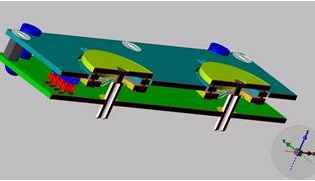Stunning: PCB motor does 2.6 million steps per revolution
on

Danish technology company PCBMotor ApS recently set a new performance record in printed circuit board (PCB) motors. In an experiment using its latest controller prototype, the company applied short micro-pulses (µpulses) to drive the motor and achieved a record 2.6 million equivalent steps per revolution.
“We’ve known for some time that PCBMotors are capable of realizing very high resolutions. And now we’ve proven it,” says Henrik Stæhr-Olsen, CEO of PCBMotor. “The driver sets the limit for what can be achieved and we can now show that resolutions over 2.5 Million µpulses per revolution are possible,” says Henrik Stæhr-Olsen.
The recently conducted experiment consisted of twenty 100 µpulse bursts, initiated manually via a USB connection to the motor controller, which resulted in the movement of a pointer, with a needle attached, against a linear code strip mounted on a ruler. “The resulting 2000 µpulses moved the needle seven ruler-lines which equates to 2 850 000 µpulses per revolution,” explains Henrik, referring to a video of the experiment that documents the results.
The prototype controller, built specifically for the experiment, is powered from the USB port and handles a wide range of settings for the motor such as pulse length and interval, drive voltage, and the number of µpulses and digital steps. Operating in open-loop mode it also has on-board memory (EEPROM) for storing the drive settings.
When in position, the PCBMotor and driver can be completely powered down, removing all mechanical and electrical interference (noise). “The experiment shows that the inherent holding torque of the motor is sufficient to stop and hold its position when the power is turned off ― unlike a stepper motor. And this is very important for high-precision applications sensitive to even the smallest movement or vibration,” says Henrik Stæhr-Olsen.
The available holding torque depends on the size of the motor and is typically 35 Nmm for a standard


Discussion (0 comments)